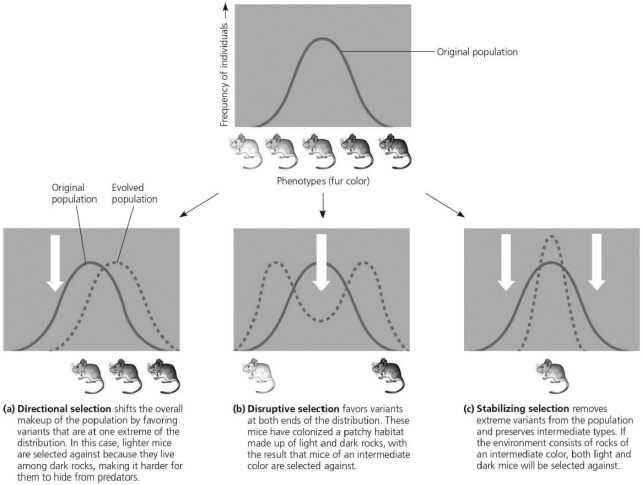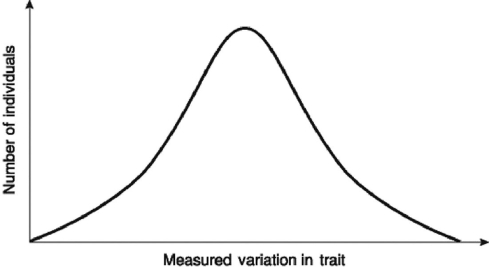A) nonrandom mating.
B) geographic isolation.
C) genetic drift.
D) gene flow.
F) B) and D)
Correct Answer

verified
Correct Answer
verified
Multiple Choice
Please use the following information to answer the question(s) below. In the year 2500, five male space colonists and five female space colonists (all unrelated to each other) settle on an uninhabited Earthlike planet in the Andromeda galaxy. The colonists and their offspring randomly mate for generations. All 10 of the original colonists had free earlobes, and 2 were heterozygous for that trait. The allele for free earlobes is dominant to the allele for attached earlobes. -If one assumes that Hardy-Weinberg equilibrium applies to the population of colonists on this planet, about how many people will have attached earlobes when the planet's population reaches 10,000?
A) 100
B) 400
C) 800
D) 1,000
E) 10,000
G) A) and C)
Correct Answer

verified
Correct Answer
verified
Multiple Choice
If, on average, 46% of the loci in a species' gene pool are heterozygous, then the average homozygosity of the species should be
A) 23%.
B) 46%.
C) 54%.
D) There is not enough information to say.
F) C) and D)
Correct Answer

verified
Correct Answer
verified
Multiple Choice
There are 25 individuals in population 1, all with genotype AA, and there are 40 individuals in population 2, all with genotype aa. Assume that these populations are located far from each other and that their environmental conditions are very similar. Based on the information given here, the observed genetic variation most likely resulted from
A) genetic drift.
B) gene flow.
C) nonrandom mating.
D) directional selection.
F) B) and C)
Correct Answer

verified
Correct Answer
verified
Multiple Choice
Which of the following is a true statement concerning genetic variation?
A) It is created by the direct action of natural selection.
B) It arises in response to changes in the environment.
C) It must be present in a population before natural selection can act upon the population.
D) It tends to be reduced by the processes involved when diploid organisms produce gametes.
E) A population that has a higher average heterozygosity has less genetic variation than one with a lower average heterozygosity.
G) A) and E)
Correct Answer

verified
Correct Answer
verified
Multiple Choice
Please use the following information to answer the question(s) below. HIV's genome of RNA includes the code for reverse transcriptase (RT) , an enzyme that acts early in infection to synthesize a DNA genome off of an RNA template. The HIV genome also codes for protease (PR) , an enzyme that acts later in infection by cutting long viral polyproteins into smaller, functional proteins. Both RT and PR represent potential targets for antiretroviral drugs. Drugs called nucleoside analogs (NA) act against RT, whereas drugs called protease inhibitors (PI) act against PR. -In a hypothetical population's gene pool, an autosomal gene, which had previously been fixed, undergoes a mutation that introduces a new allele, one inherited according to incomplete dominance. Natural selection then causes stabilizing selection at this locus. Consequently, what should happen over the course of many generations?
A) The proportions of both types of homozygote should decrease.
B) The proportion of the population that is heterozygous at this locus should remain constant.
C) The population's average heterozygosity should decrease.
D) The two homozygotes should decrease at different rates.
F) B) and C)
Correct Answer

verified
Correct Answer
verified
Multiple Choice
Please use the following information to answer the question(s) below. In the year 2500, five male space colonists and five female space colonists (all unrelated to each other) settle on an uninhabited Earthlike planet in the Andromeda galaxy. The colonists and their offspring randomly mate for generations. All 10 of the original colonists had free earlobes, and 2 were heterozygous for that trait. The allele for free earlobes is dominant to the allele for attached earlobes. -Which of these is closest to the allele frequency in the founding population?
A) 0.1 a, 0.9 A
B) 0.2 a, 0.8 A
C) 0.5 a, 0.5 A
D) 0.8 a, 0.2 A
E) 0.4 a, 0.6 A
G) A) and C)
Correct Answer

verified
Correct Answer
verified
Multiple Choice
Please use the following information to answer the question(s) below. In the year 2500, five male space colonists and five female space colonists (all unrelated to each other) settle on an uninhabited Earthlike planet in the Andromeda galaxy. The colonists and their offspring randomly mate for generations. All 10 of the original colonists had free earlobes, and 2 were heterozygous for that trait. The allele for free earlobes is dominant to the allele for attached earlobes. -"Until the agricultural revolution 10,000 years ago, people used to live in small populations with little gene flow between them. That is the best situation for rapid evolution," said Sewall Wright, one of the founders of population genetics.This conclusion on gene flow conflicts with Hardy-Weinberg equilibrium, which states that no gene flow means
A) natural selection.
B) no genetic drift.
C) no random mating.
D) no evolution.
F) B) and D)
Correct Answer

verified
Correct Answer
verified
Multiple Choice
How can gene flow improve adaptation of population?
A) alleles mutate in different geographical areas
B) alleles increase in frequency in original population
C) beneficial alleles are transferred to a new population
D) allele frequencies decrease in new population
F) B) and C)
Correct Answer

verified
Correct Answer
verified
Multiple Choice
Please use the following information to answer the question(s) below.  -Examining the figure, which type of selection has two peaks of frequency of individuals?
-Examining the figure, which type of selection has two peaks of frequency of individuals?
A) directional selection
B) disruptive selection
C) stabilizing selection
D) natural selection
F) A) and C)
Correct Answer

verified
Correct Answer
verified
Multiple Choice
 Figure 21.3
In a very large population, a quantitative trait has the distribution pattern shown in Figure 21.3. If the curve in Figure 21.3 shifts to the left or to the right, there is no gene flow, and the population size consequently increases over successive generations. Which of the following is (are) probably occurring?
1) immigration or emigration
2) directional selection
3) adaptation
4) genetic drift
5) disruptive selection
Figure 21.3
In a very large population, a quantitative trait has the distribution pattern shown in Figure 21.3. If the curve in Figure 21.3 shifts to the left or to the right, there is no gene flow, and the population size consequently increases over successive generations. Which of the following is (are) probably occurring?
1) immigration or emigration
2) directional selection
3) adaptation
4) genetic drift
5) disruptive selection
A) 1 only
B) 4 only
C) 2 and 3
D) 4 and 5
E) 1, 2, and 3
G) None of the above
Correct Answer

verified
Correct Answer
verified
Multiple Choice
What is the Hardy-Weinberg equation?
A) an assessment of evolution at a particular locus
B) a determination of allele frequency
C) a determination of genotype frequency
D) an assessment of heterozygosity in a population
F) B) and C)
Correct Answer

verified
Correct Answer
verified
Multiple Choice
Sexual dimorphism is most often a result of
A) pansexual selection.
B) stabilizing selection.
C) intrasexual selection.
D) intersexual selection.
E) artificial selection.
G) C) and D)
Correct Answer

verified
Correct Answer
verified
Multiple Choice
Evolution
A) must happen, due to organisms' innate desire to survive.
B) must happen whenever a population is not well adapted to its environment.
C) can happen whenever any of the conditions for Hardy-Weinberg equilibrium are not met.
D) requires the operation of natural selection.
F) C) and D)
Correct Answer

verified
Correct Answer
verified
Multiple Choice
Whenever diploid populations are in Hardy-Weinberg equilibrium at a particular locus,
A) the allele's frequency should not change from one generation to the next, but its representation in homozygous and heterozygous genotypes may change.
B) natural selection, gene flow, and genetic drift are acting equally to change an allele's frequency.
C) this means that, at this locus, two alleles are present in equal proportions.
D) the population itself is not evolving, but individuals within the population may be evolving.
F) A) and D)
Correct Answer

verified
Correct Answer
verified
Multiple Choice
Please use the following information to answer the question(s) below. You are studying three populations of birds. Population A has 10 birds, of which 1 is brown (a recessive trait) and 9 are red. Population B has 100 birds, of which 10 are brown. Population C has 30 birds, and 3 of them are brown. -In which population would it be least likely that an accident would significantly alter the frequency of the brown allele?
A) population A
B) population B
C) population C
D) They are all the same.
F) All of the above
Correct Answer

verified
Correct Answer
verified
Multiple Choice
What is the result of adaptive evolution?
A) formation of new genetic variants
B) sorting by natural selection
C) increase in frequency of alleles that provide reproductive advantage
D) survival of the fittest
F) A) and C)
Correct Answer

verified
Correct Answer
verified
Multiple Choice
Please use the following information to answer the question(s) below. In those parts of equatorial Africa where the malaria parasite is most common, the sickle-cell allele constitutes 20% of the β hemoglobin alleles in the human gene pool. -In the United States, the parasite that causes malaria is not present, but African-Americans whose ancestors were from equatorial Africa are present. What should be happening to the sickle-cell allele in the United States, and what should be happening to it in equatorial Africa?
A) stabilizing selection; disruptive selection
B) disruptive selection; stabilizing selection
C) disruptive selection; directional selection
D) directional selection; disruptive selection
F) None of the above
Correct Answer

verified
Correct Answer
verified
Multiple Choice
What is the founder effect?
A) a selection of the best-suited traits for the environment
B) a series of chance events that change allele frequency
C) when a few individuals become isolated from a larger population, and their gene pool differs from that source population
D) a sudden change in the environment that reduces the size of the population
F) B) and D)
Correct Answer

verified
Correct Answer
verified
Multiple Choice
Please use the following information to answer the question(s) below. In the year 2500, five male space colonists and five female space colonists (all unrelated to each other) settle on an uninhabited Earthlike planet in the Andromeda galaxy. The colonists and their offspring randomly mate for generations. All 10 of the original colonists had free earlobes, and 2 were heterozygous for that trait. The allele for free earlobes is dominant to the allele for attached earlobes. -Mountains also have an unmatched power to drive human evolution. Starting tens of thousands of years ago, people moved to high altitudes, and there they experienced natural selection that has reworked their biology. In Tibet, for example, people have broader arteries and capillaries. In the Andes, they can dissolve more oxygen into their blood. These different traits of people who live in high altitudes illustrate
A) stabilizing evolution.
B) sexual selection.
C) adaptive evolution.
D) directional selection.
F) None of the above
Correct Answer

verified
Correct Answer
verified
Showing 41 - 60 of 70
Related Exams